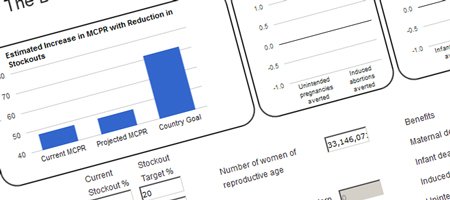Reducing Stockouts Impact Calculator
Stockouts of contraceptive supplies can discourage use of modern family planning by making it more difficult for potential users to get their method of choice.
Stockouts may be defined in several ways:
- Percentage of facilities where the method was not available on the day of the survey
- Percentage of service delivery points with stockouts at any time during the last six months
- Percentage of days when a method was not available at a facility
Steps to use the model
Steps to use the model
This model provides an idea of the magnitude of the potential benefits to be gained by reducing or eliminating stockouts. It follows several steps:
- Select a country from the dropdown list at the top of the screen
- Describe the current situation in terms of the level of stockouts by method
- The model will provide this information if it is available or use average values if no country-specific information is available
- You may change the current stockout rates if you have better data
- Define a target
- You may explore the effects of reducing stockouts to zero for all methods, or try some intermediate targets
- Review model estimate of impact on the modern contraceptive prevalence rate (MCPR)
- The impact is shown in the both the graph and the box at the bottom of the screen
- Review the benefits of increased MCPR due to reductions in stockouts
Methods
Methods
The model is based on an analysis by Futures Institute that used three different approaches to estimate the effects of stockouts on MCPR. These approaches are based on the following analyses.
- A multilevel analysis of method availability and CPR at the sub-national level in East Africa (Wang W, Wang S. How Does the Family Planning Supply and Service Environment Affect Contraceptive Use? Findings from Four East African Countries. Measure DHS, ICF Macro, August 25, 2011.
- A national cross-section analysis of method availability and CPR (Karim, Ali Mehryar, Briton Bieze, and Jaya Chimnani. 2008. Measuring Family Planning Logistics System Performance in Developing Countries: Working Paper. Arlington, Va.: USAID | DELIVER PROJECT, Task Order 1.)
- A cross-section analysis of the relationship between method availability as measured by the Family Planning Effort Scores and MCPR (Ross J, Stover J. Use of Modern Contraception Increases When More Methods Become Available, 2013, forthcoming in Global Health: Science and Practice)
These analyses indicate that adding or removing one method results in a change in MCPR of 5-8 points. This model uses this relationship and equates a partial stockout with a partial loss of a method. The model sums to stockout rates for the five methods shown for both the current situation and the target. The difference is multiplied by 7 points to estimate the increase in MCPR resulting from achieving the target.
The additional benefits of increased use of modern methods area calculated from the number of additional users and the benefits per user as reported in Adding It Up (Adding It Up: The Costs and Benefits of Investing in Family Planning and Maternal and Newborn Health, Guttmacher Institute and UNFPA, 2009.). These are 3153 additional users per maternal death averted, 251 additional users per infant death averted, 6.46 additional users per abortion averted and 3.63 additional users per unintended pregnancy averted.
Results
Results
The results are intended to illustrate the magnitude of benefits to be expected from a focus on reducing stockouts. Since the impacts are based on international averages the results will not be precise for each country-setting. In addition, good data on the current extent of stockouts are not available for all countries. Nevertheless, this model can be used to illustrate the importance of efforts to reduce or eliminate stockouts as a barrier to expanded access to family planning.
